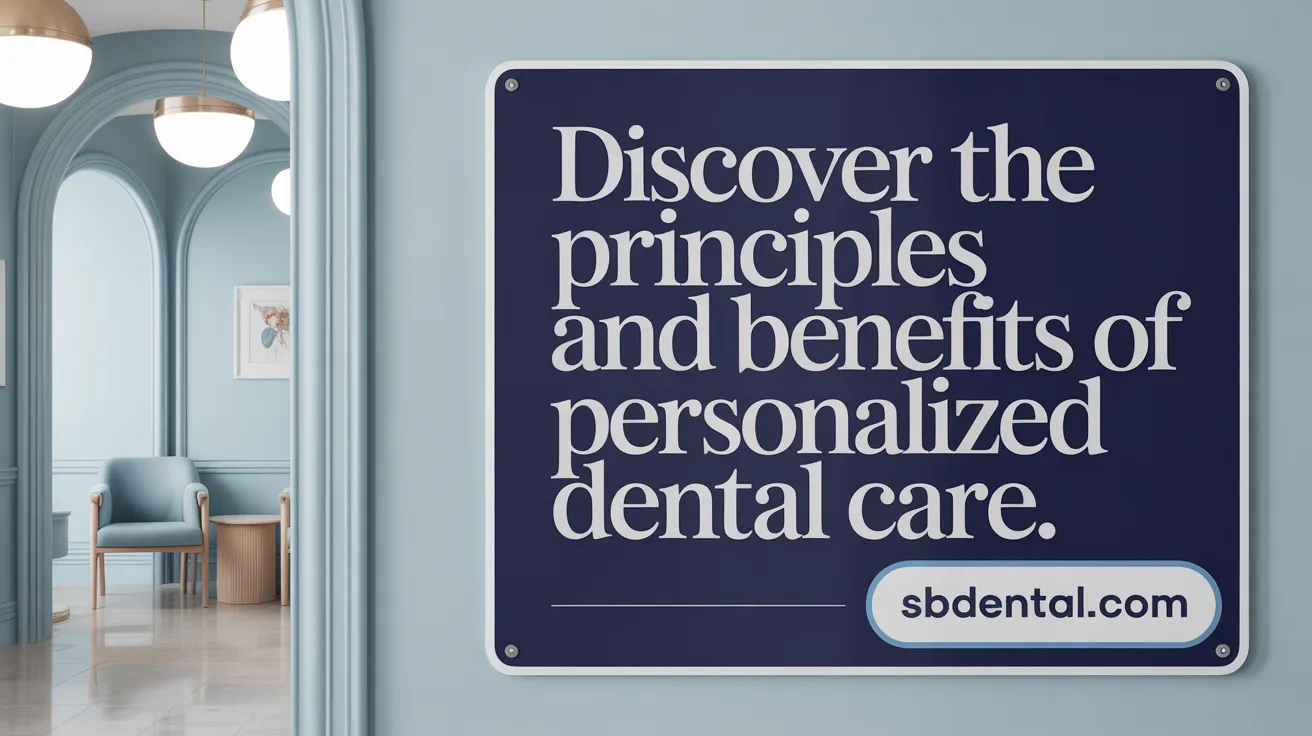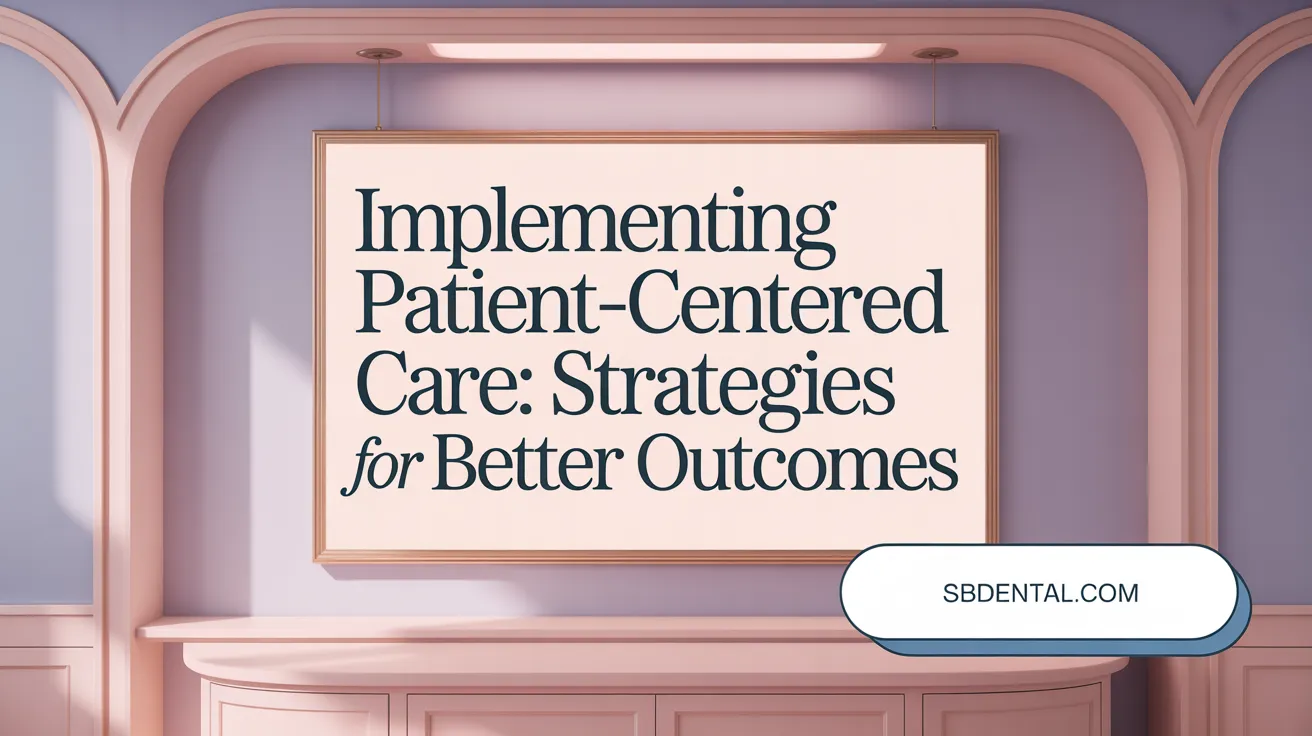Introduction to Personalized Dental Care
Personalized dental care is reshaping the patient experience by focusing on individualized treatment plans that consider each patient's unique oral health needs, lifestyle, and preferences. This approach not only enhances clinical outcomes but also fosters stronger patient-dentist relationships, elevates comfort, and increases satisfaction. As dental practices evolve, embracing personalized care is becoming essential to meet growing patient expectations and improve overall oral health.
Principles and Benefits of Personalized Dental Care

What are the principles and benefits of personalized dental care?
Personalized dental care is centered around customizing treatments and communication to suit each patient’s individual needs, preferences, and health history. This approach recognizes that every patient has unique dental concerns, risk factors, and lifestyle considerations that influence how they should be treated (Personalized dental care, Patient-centred care in dentistry).
One fundamental principle is tailoring treatments based on specific risk factors such as enamel erosion, gum disease, or teeth grinding. By evaluating medical history and oral health status, dentists can develop targeted preventive measures and treatment plans that are more effective and comfortable (Customized dental treatment benefits, Tailored dental treatments).
This customized approach leads to better treatment outcomes. Patients experience increased comfort and confidence because procedures address their particular concerns and reduce unnecessary discomfort. Personal involvement and shared decision-making foster trust, boosting adherence to treatment and follow-up recommendations (Benefits of Personalized Dental Care, Patient-centred care (PCC)).
Advances in technology, such as digital imaging, risk assessment tools, and tele-dentistry, support precise diagnostics and ongoing monitoring. Regular follow-ups allow dentists to update and adjust plans to maintain optimal health (Modern dental clinics, Personalized dental care through data and technology).
The ultimate goal of personalized dental care is to prevent issues before they develop, lower the frequency of invasive procedures, and promote overall well-being. By focusing on the individual, this approach ensures a more satisfying, efficient, and effective dental experience—a win for patients and practitioners alike (The importance of a personalized dental care plan, Patient-centred care in dentistry).
Implementing Patient-Centered Care: Strategies and Challenges

What is patient-centered care (PCC) in dentistry?
Patient-centered care (PCC) in dentistry focuses on respecting and responding to individual patients' preferences, needs, and values. It ensures that clinical decisions are guided by what matters most to the patient, rather than solely focusing on the biological aspects of treatment. PCC considers the patient as a whole, including their biopsychosocial circumstances, lifestyle, and overall health. It emphasizes holistic, respectful collaboration between the dentist and patient, aiming for better health outcomes and higher satisfaction (patient-centered care in oral health).
What training and education do dental professionals need?
Implementing effective PCC requires that dental professionals undergo specialized training in communication skills, cultural competence, and shared decision-making. Currently, such training is often limited as most knowledge is acquired through on-the-job experience. Incorporating comprehensive PCC education into undergraduate curricula and continuous professional development can improve understanding of how to engage patients meaningfully (Healthcare approach emphasizing patient preferences, systemic healthcare factors in dentistry).
How does patient involvement and shared decision-making enhance care?
Encouraging patient participation in treatment planning fosters trust and ensures that care aligns with their personal goals and concerns. Shared decision-making involves dialogue, where both the dentist and patient exchange information, clarify options, and agree on the best course. This approach reduces uncertainty, improves adherence, and enhances overall satisfaction (sharing decision-making in dentistry, patient-centered approach in dentistry).
How can practices create welcoming environments?
A comfortable, friendly environment is essential for encouraging patient engagement. This can include inviting waiting areas, clear signage, approachable staff, and privacy during consultations. Visual aids, such as digital imaging or treatment outcome simulations, can help demystify procedures and reassure patients (welcoming dental waiting room, modern dental clinics).
What role do visual aids and clear communication play?
Visual tools and straightforward language enable better understanding, especially when discussing complex treatments or risks. Using models, diagrams, and digital imagery enhances communication, reduces misunderstandings, and empowers patients to make informed choices (Effective dentist-patient communication, 5 Cs of communication in dentistry).
How can PCC be integrated with broader healthcare systems?
Connecting dental care with primary healthcare services supports holistic management of patient health. Sharing records, collaborating with physicians, and adopting integrated health approaches promote comprehensive patient care. Mobile clinics and teledentistry can extend services to underserved populations, fostering inclusivity (person-centered care in dentistry, teledentistry for oral health).
What are the barriers to implementing PCC and systemic challenges?
Challenges include the lack of explicit guidelines, limited training, and insufficient systemic support for PCC principles. Variations in understanding and applying PCC, along with time constraints and systemic healthcare barriers, hinder widespread adoption. Addressing these issues requires policy development, education reform, and organizational commitment to prioritize patient-centered approaches (Challenges of implementing PCC in dentistry, barriers to patient-centred care implementation).
Enhancing Communication to Build Trust and Improve Outcomes
 Effective communication is a cornerstone of excellent dental care and significantly influences patient trust, satisfaction, and treatment success. It involves a continuous, two-way exchange where both the dentist and patient share information openly and honestly.
Effective communication is a cornerstone of excellent dental care and significantly influences patient trust, satisfaction, and treatment success. It involves a continuous, two-way exchange where both the dentist and patient share information openly and honestly.
One of the main strategies to improve dentist-patient communication is adopting a patient-centered approach. This method emphasizes understanding each patient’s unique needs, concerns, and expectations. Active listening, asking open-ended questions, and encouraging feedback help dentists grasp patient perspectives better.
Using simple language avoids confusing jargon, making explanations more accessible. Visual aids like diagrams, models, and digital apps can enhance understanding, particularly for complex procedures or treatment options. Non-verbal cues such as maintaining eye contact, using positive body language, and demonstrating empathy also play vital roles in building rapport.
Ongoing staff training is crucial for refining communication skills. Continued professional development ensures that dental teams stay informed about best practices and emerging tools for effective interaction.
Modern digital communication tools, including instant messaging, email, and tele-dentistry platforms, facilitate timely, convenient, and clear interactions. These technologies support remote follow-ups, address patient questions swiftly, and reduce anxiety associated with visits.
Transparency about treatment options and associated costs helps set realistic expectations and fosters trust. Clear discussions about what to expect, potential risks, and financial considerations can significantly improve compliance and patient satisfaction.
Moreover, implementing feedback mechanisms, such as satisfaction surveys or post-visit calls, allows practices to identify areas for improvement and demonstrate care beyond immediate treatment.
In summary, combining personalized, clear, and compassionate communication strategies—supported by ongoing staff training and modern digital tools—strengthens the dentist-patient relationship, leading to better health outcomes and an improved overall experience.
Creating Comfortable and Engaging Dental Environments

What techniques create a comfortable and patient-friendly dental environment?
Designing a welcoming dental setting is essential for reducing patient anxiety and enhancing the overall experience. One effective strategy involves using calming color schemes throughout the practice. Shades such as warm neutrals, pastels, and cool tones like blue and green can positively influence mood, promote relaxation, and foster trust.
Incorporating soothing elements like soft lighting, natural light sources, water features, and the subtle use of aromatherapy with scents such as lavender can further diminish stress levels. These sensory additions help create an environment that feels safe and serene.
Waiting and treatment areas should be equipped with amenities that entertain and distract patients. Television screens, interactive wall games, and themed rooms can make visits more enjoyable, especially for children or anxious individuals. For more ideas on dental office entertainment options, see this resource.
Streamlining patient experiences through technological innovations also plays a significant role. Online check-in options, clear educational videos about procedures, and digital forms minimize waiting times and confusion. These features are part of the modern dental clinics’ approach to improve patient comfort and care.
Equally important is staff behavior. Empathetic, friendly, and supportive staff members who exhibit patience and understanding can significantly influence patient comfort. Their demeanor, combined with the physical environment, contributes to an overall atmosphere that encourages openness and trust. The role of staff training in emotional intelligence is critical in this context.
By integrating these elements—thoughtful design, calming decor, engaging distractions, and compassionate staff—dental practices can cultivate a space where patients feel relaxed, respected, and cared for, making each visit a positive experience. For a comprehensive overview of enhancing the dental patient experience, refer to this article.
Leveraging Feedback and Technology to Improve Care and Loyalty
What are the best practices for collecting and using patient feedback to improve dental care?
Effective collection of patient feedback involves employing diverse methods tailored to different stages of treatment. Practices should utilize concise, relevant surveys distributed through digital platforms, email, or in-office tablets, ensuring they respect patient time and privacy. Follow-up calls and online reviews on trusted sites like HealthGrades add depth to understanding patient experiences. Analyzing feedback with tools like Natural Language Processing (NLP) and expert review helps identify recurring themes, such as communication quality, courtesy, and appointment accessibility. Using metrics like the Net Promoter Score (NPS) and treatment satisfaction ratings guides targeted improvements. Sharing results transparently with the dental team fosters a culture of continuous quality enhancement. Encouraging positive community reviews further builds trust and attracts new patients.
How do innovations support personalized dental patient care?
Technological advancements are transforming personalized dentistry. Digital imaging and 3D printing enable precise diagnostics and tailor-made restorations, increasing treatment accuracy and efficiency. AI-driven diagnostic tools assess risk factors for cavities, gum disease, and other conditions, helping customize prevention strategies. Teledentistry enhances access, allowing patients to consult remotely, discuss concerns, and receive personalized advice without frequent clinic visits. Intraoral cameras and digital impressions improve communication, demonstrating potential outcomes visually, which enhances understanding and engagement. Laser dentistry, regenerative treatments, and guided implant procedures offer minimally invasive, patient-specific options that reduce discomfort and recovery time. These innovations allow dental professionals to design care plans that align exactly with individual health needs and preferences, boosting satisfaction and outcomes.
Conclusion: The Future of Dental Care is Personalized
Personalized dental care represents a transformative approach that aligns treatments with each patient's unique needs, preferences, and life context. By embracing patient-centered principles, enhancing communication, creating comfortable environments, and leveraging technology and patient feedback, dental practices can substantially elevate patient satisfaction, improve treatment outcomes, and foster long-term loyalty. As innovations continue to emerge, integrating these strategies will not only enhance oral health but also redefine the patient experience—making dental care more compassionate, effective, and tailored for the diverse individuals it serves.
